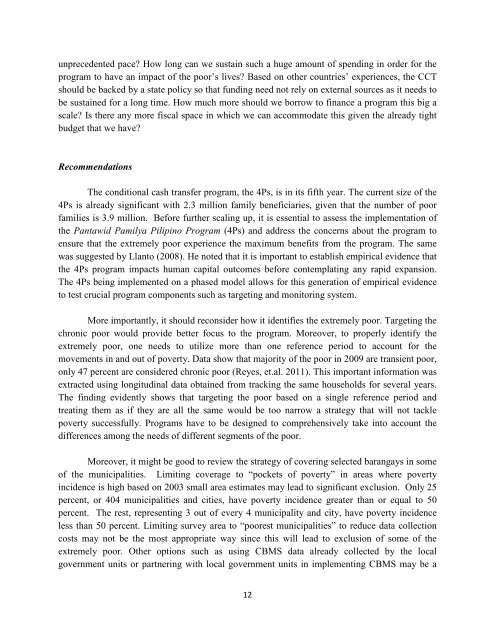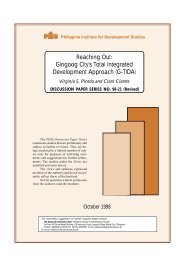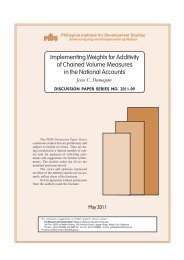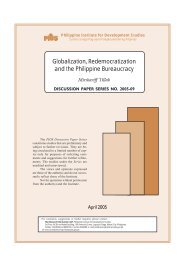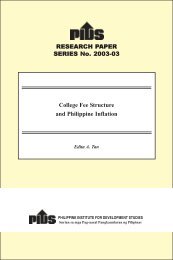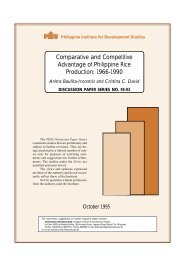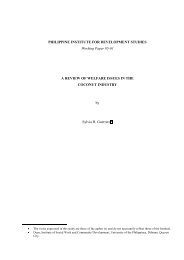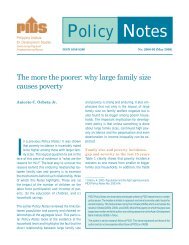The CCT programmes have been fairly successful <strong>in</strong> upper middle-<strong>in</strong>come countries likeBrazil and Mexico, but this does not mean that it can work <strong>in</strong> all countries. Several low-<strong>in</strong>comecountries which have adopted <strong>the</strong> model like Guatemala, Honduras and Nicaragua have facedimmense challenges <strong>in</strong> implement<strong>in</strong>g CCT programmes because <strong>the</strong>y did not meet <strong>the</strong> necessaryprerequisites (Cecch<strong>in</strong>i, 2009). The first requirement is that <strong>the</strong>re has to be a multidimensionalapproach to poverty reduction, hence demand<strong>in</strong>g coord<strong>in</strong>ation among all agencies implement<strong>in</strong>gpoverty reduction efforts. Therefore, strong and coord<strong>in</strong>ated <strong>in</strong>stitutions are critical. Second, ithas to be a state policy where<strong>in</strong> <strong>the</strong> programme can withstand changes <strong>in</strong> adm<strong>in</strong>istrations andfund<strong>in</strong>g must not rely from external sources for <strong>the</strong> programme needs to be susta<strong>in</strong>ed for a longperiod of time. Third, <strong>the</strong>re has to be strong statistical capacity and bank<strong>in</strong>g systems. Suchimportant prerequisites are often lack<strong>in</strong>g <strong>in</strong> low-<strong>in</strong>come countries (Cecch<strong>in</strong>i, 2009).Ano<strong>the</strong>r important requirement to achieve successful results from <strong>the</strong> CCT is thatimpos<strong>in</strong>g conditions should mean that <strong>the</strong> necessary services are <strong>in</strong> fact <strong>in</strong> place and that <strong>the</strong>y areof good quality. For <strong>in</strong>stance, provid<strong>in</strong>g some cash to families on <strong>the</strong> condition that <strong>the</strong>ir childrenattend school or do health check-ups is <strong>in</strong>appropriate <strong>in</strong> areas where <strong>the</strong>re are no school oraccessible health centers nearby to go to. Thus, CCT funds should not only be devoted tostimulat<strong>in</strong>g demand for social services but also by <strong>in</strong>creas<strong>in</strong>g <strong>the</strong> supply of social services likeeducation and health services to meet <strong>the</strong> <strong>in</strong>creas<strong>in</strong>g demands.In 2008, when <strong>the</strong> Philipp<strong>in</strong>es launched nationwide <strong>the</strong> CCT, <strong>the</strong>re were still greatshortages <strong>in</strong> classrooms and school teachers and various issues still plague <strong>the</strong> health sector. In2011, <strong>the</strong> supply side allocations for <strong>the</strong> 4Ps <strong>in</strong>clude 12.4 billion pesos for build<strong>in</strong>g classroomsand 1.6 billion pesos for <strong>the</strong> creation of 10,000 teach<strong>in</strong>g positions. The government alsoallocated 7.1 billion pesos for upgrad<strong>in</strong>g of health facilities (NAPC Part 1, 2011). Hence, <strong>the</strong>government realizes <strong>the</strong> importance of supply-side factors to achieve <strong>the</strong> goals of <strong>the</strong> 4Ps. Thus,it would have been better to put <strong>in</strong> place <strong>the</strong>se facilities prior to ra<strong>the</strong>r than concurrently with <strong>the</strong>expansion of <strong>the</strong> program. Hence, <strong>the</strong> lack of preparedness towards full implementation of <strong>the</strong>CCT was truly one of <strong>the</strong> critical issues. Moreover, <strong>in</strong> 2011, <strong>the</strong> NAPC writes that <strong>the</strong>re were somany uncoord<strong>in</strong>ated and overlapp<strong>in</strong>g poverty-reduction-related programs reflect<strong>in</strong>g <strong>the</strong> lack ofcoord<strong>in</strong>ative mechanisms among various agencies.Apparently, <strong>the</strong> Philipp<strong>in</strong>es lack preparedness based on <strong>the</strong> requirements described <strong>in</strong>Cecch<strong>in</strong>i (2009). Fernandez and Olf<strong>in</strong>do (2011) noted that <strong>the</strong> program was scaled up when <strong>the</strong>systems were still under development and this posed considerable challenges <strong>in</strong> <strong>the</strong>implementation. In particular, <strong>the</strong> study noted that <strong>the</strong> rigid <strong>in</strong>stitutional structure and weakprocurement system have constra<strong>in</strong>ed <strong>the</strong> expansion of human and capital support for <strong>the</strong>Pantawid Pamilya. Fur<strong>the</strong>rmore, <strong>the</strong> study highlighted that <strong>the</strong> rapid expansion has also posedchallenges to supply-side read<strong>in</strong>ess <strong>in</strong> areas where Pantawid Pamilya were implemented. Thereare several questions that need answers. Why <strong>the</strong> rush <strong>in</strong> implement<strong>in</strong>g <strong>the</strong> program at such an11
unprecedented pace? How long can we susta<strong>in</strong> such a huge amount of spend<strong>in</strong>g <strong>in</strong> order for <strong>the</strong>program to have an impact of <strong>the</strong> poor’s lives? Based on o<strong>the</strong>r countries’ experiences, <strong>the</strong> CCTshould be backed by a state policy so that fund<strong>in</strong>g need not rely on external sources as it needs tobe susta<strong>in</strong>ed for a long time. How much more should we borrow to f<strong>in</strong>ance a program this big ascale? <strong>Is</strong> <strong>the</strong>re any more fiscal space <strong>in</strong> which we can accommodate this given <strong>the</strong> already tightbudget that we have?RecommendationsThe conditional cash transfer program, <strong>the</strong> 4Ps, is <strong>in</strong> its fifth year. The current size of <strong>the</strong>4Ps is already significant with 2.3 million family beneficiaries, given that <strong>the</strong> number of poorfamilies is 3.9 million. Before fur<strong>the</strong>r scal<strong>in</strong>g up, it is essential to assess <strong>the</strong> implementation of<strong>the</strong> Pantawid Pamilya Pilip<strong>in</strong>o <strong>Program</strong> (4Ps) and address <strong>the</strong> concerns about <strong>the</strong> program toensure that <strong>the</strong> extremely poor experience <strong>the</strong> maximum benefits from <strong>the</strong> program. The samewas suggested by Llanto (2008). He noted that it is important to establish empirical evidence that<strong>the</strong> 4Ps program impacts human capital outcomes before contemplat<strong>in</strong>g any rapid expansion.The 4Ps be<strong>in</strong>g implemented on a phased model allows for this generation of empirical evidenceto test crucial program components such as target<strong>in</strong>g and monitor<strong>in</strong>g system.More importantly, it should reconsider how it identifies <strong>the</strong> extremely poor. Target<strong>in</strong>g <strong>the</strong>chronic poor would provide better focus to <strong>the</strong> program. Moreover, to properly identify <strong>the</strong>extremely poor, one needs to utilize more than one reference period to account for <strong>the</strong>movements <strong>in</strong> and out of poverty. Data show that majority of <strong>the</strong> poor <strong>in</strong> 2009 are transient poor,only 47 percent are considered chronic poor (Reyes, et.al. 2011). This important <strong>in</strong>formation wasextracted us<strong>in</strong>g longitud<strong>in</strong>al data obta<strong>in</strong>ed from track<strong>in</strong>g <strong>the</strong> same households for several years.The f<strong>in</strong>d<strong>in</strong>g evidently shows that target<strong>in</strong>g <strong>the</strong> poor based on a s<strong>in</strong>gle reference period andtreat<strong>in</strong>g <strong>the</strong>m as if <strong>the</strong>y are all <strong>the</strong> same would be too narrow a strategy that will not tacklepoverty successfully. <strong>Program</strong>s have to be designed to comprehensively take <strong>in</strong>to account <strong>the</strong>differences among <strong>the</strong> needs of different segments of <strong>the</strong> poor.Moreover, it might be good to review <strong>the</strong> strategy of cover<strong>in</strong>g selected barangays <strong>in</strong> someof <strong>the</strong> municipalities. Limit<strong>in</strong>g coverage to “pockets of poverty” <strong>in</strong> areas where poverty<strong>in</strong>cidence is high based on 2003 small area estimates may lead to significant exclusion. Only 25percent, or 404 municipalities and cities, have poverty <strong>in</strong>cidence greater than or equal to 50percent. The rest, represent<strong>in</strong>g 3 out of every 4 municipality and city, have poverty <strong>in</strong>cidenceless than 50 percent. Limit<strong>in</strong>g survey area to “poorest municipalities” to reduce data collectioncosts may not be <strong>the</strong> most appropriate way s<strong>in</strong>ce this will lead to exclusion of some of <strong>the</strong>extremely poor. O<strong>the</strong>r options such as us<strong>in</strong>g CBMS data already collected by <strong>the</strong> localgovernment units or partner<strong>in</strong>g with local government units <strong>in</strong> implement<strong>in</strong>g CBMS may be a12


